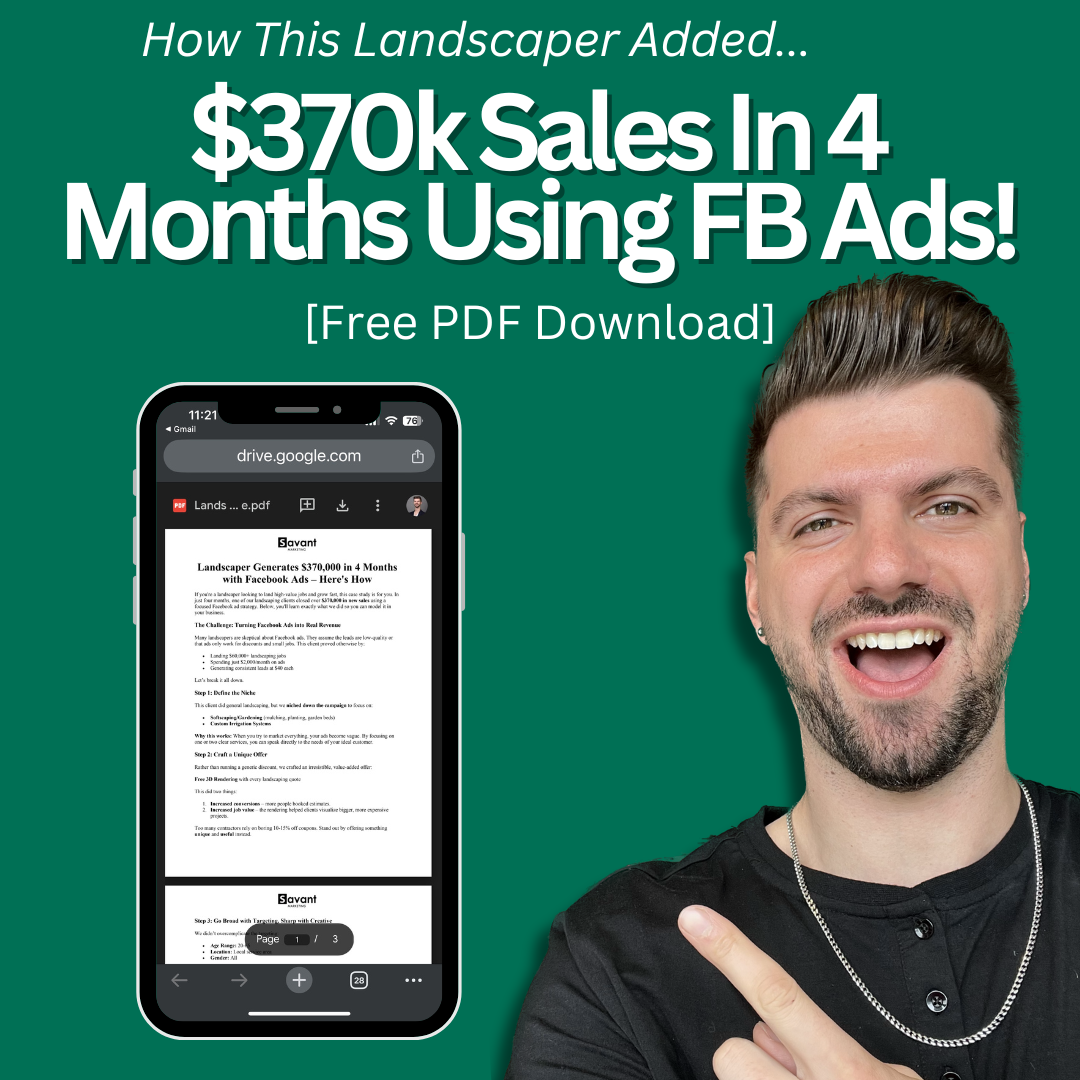Landscaper Marketing: How To Revive DEAD LEADS and Flood Your Calendar in 7 Days!
What if right now, sitting in your CRM or on your email list, there were tens of thousands, or even hundreds of thousands of dollars in potential sales just waiting for you to pick them up?
And what if you could tap into those opportunities in as little as one week?
That’s exactly what a reactivation campaign does. It’s one of the fastest, most reliable ways for landscapers, lawn care companies, and outdoor living contractors to turn old leads into booked jobs.
At Savant Marketing, we’ve run this exact strategy for contractors across North America and seen it generate a flood of booked projects in a matter of days. While it works year-round, it’s especially powerful during slower seasons or near the end of the year when you want to fill your schedule before winter.
Here’s how to run it, step by step.
Step 1: Pick Your Campaign Week
The first key to a successful reactivation campaign is choosing when you’re going to run it—and just as important, having a specific window of opportunity for your offers to be available.
- Seasonal transitions: Whether it’s the shift from summer to fall, winter to spring, or another change in the seasons, these moments get homeowners thinking about their property and what they’d like to improve before the next phase of the year.
- Before peak booking periods: Launching a reactivation campaign just ahead of your busiest season can help you fill the schedule early and lock in your best clients before competitors even start marketing.
- During slow stretches: Every business has periods where work slows down. A reactivation campaign can inject quick revenue during these lulls without the need for a public sale or large ad spend.
- Ahead of natural deadlines: Think about moments when customers might feel pressure to complete a project: before a major holiday, before hosting an event, or before the weather makes certain work impossible.
Step 2: Create a Strong Offer and Tailored Messaging
A reactivation campaign is not about chasing cold prospects or broadcasting a generic promotion. It is specifically designed for people who have already shown real interest in your services. These are individuals who have received an estimate, had a conversation with you, and pictured the work being done, but for one reason or another did not move forward.
That distinction matters. Because these leads already know who you are, your messaging can be far more direct, specific, and personal. You are not introducing yourself. You are simply giving them a compelling reason to take the final step.
One of the simplest and most effective ways to do that is with a “flash sale” on their existing proposal.
For example: “For this week only, we’re taking 10% off any proposal you’ve received from us. Just reply with the word SALE to lock it in before [date].”
This kind of offer works because:
- They already know the price, so there is no need to re-quote.
- It feels exclusive, since it is clearly meant just for them.
- It has a built-in deadline, which triggers action.
The discount does not have to be huge. A range of 5 to 10 percent is often enough, but it should be meaningful enough to push someone off the fence. You are not trying to devalue your work. You are giving them a reason to say “yes” now instead of later.
If you prefer not to offer a discount, you can replace it with a value-add bonus. Examples include:
- An extended warranty at no additional cost.
- A complimentary add-on service, such as an extra planting, lawn treatment, or lighting upgrade.
- A seasonal maintenance service bundled in after the project is completed.
Whatever you choose, keep the offer simple. Avoid lengthy conditions or complicated terms. The most effective reactivation offers have three qualities:
- They can understand it instantly.
- They know it is only for them.
- It's easy to claim by replying with a single word.
Pair your offer with a short, straightforward message that ends with a strong call-to-action. Your goal is to remove every ounce of friction from the process so it feels almost effortless for them to respond.
Step 3: Reach Out on Multiple Channels
One of the biggest mistakes businesses make with reactivation campaigns is relying on a single method of communication. Your old leads are scattered across different habits and preferences.
Some check email daily, others respond instantly to texts, and a few may be more likely to listen to a voicemail than read a message. If you limit yourself to just one channel, you are guaranteed to miss opportunities.
The strength of a reactivation campaign lies in its ability to meet prospects where they already are. Since these people are in your database, you are not blasting the public with a sale. You are having a private conversation with someone who is already familiar with your business. That privacy allows you to be more direct, and that directness works even better when it is reinforced across multiple channels.
The most effective campaigns typically use three main touchpoints:
- Email: Clearly outline the offer, emphasize the deadline, and give them a single, simple way to respond. Keep it concise and easy to read so they can grasp it in seconds.
- SMS/Text Message: Deliver the same core message in a short, snappy format. Texts are read quickly and often get faster replies than email.
- Ringless Voicemail Drop: Send a short, friendly recorded message that lands directly in their voicemail inbox without their phone ringing. Hearing your voice adds a personal, trustworthy element to the offer.
The magic happens when these channels work together. Someone might miss your email but see your text. They might ignore the text but listen to your voicemail later that evening. Each touchpoint reinforces the message, increases familiarity, and keeps your offer top-of-mind until they are ready to respond.
The more ways you can remind them without being intrusive, the higher your chances of turning an old lead into a booked job.
Step 4: Follow a Reminder Cadence
One email or text message is rarely enough to get the job done. People are busy, inboxes are crowded, and a single message can easily be missed or forgotten. Even if someone sees your first communication and is interested, they may plan to respond later and never get around to it. That is why a structured reminder cadence is critical for a reactivation campaign.
A reminder cadence is simply a planned schedule for sending follow-up messages during the week of your campaign. By staying in front of your prospects at set intervals, you keep the offer top-of-mind and give them multiple chances to act. The goal is not to overwhelm them but to ensure that when they are ready to make a decision, your message is the one they see.
Here is a proven structure for a one-week campaign:
- Day 1: Send the first email, the first text message, and your voicemail drop. This is the official launch of your campaign, and you want it to make a strong impression. Clearly state the offer, the expiration date, and exactly how to claim it.
- Midweek: Send a reminder email and text message. Keep it friendly but direct. Restate the offer, include the deadline, and prompt them to respond. This is a good time to add a quick benefit or reassurance, such as availability for immediate scheduling.
- Final day: Send a “Final Notice” email and text. Emphasize that the offer expires that day and specify the exact time it will end. Make the urgency real by letting them know this is their last chance to take advantage of it.
Every touchpoint should clearly restate the offer, the expiration date, and the simple action you want them to take. Avoid making the messages too long or adding new, complicated details. Consistency and clarity are what make this approach work.
When done correctly, many of your responses will come from the final-day reminder. People often wait until the last possible moment to act, and that last nudge can make the difference between a missed opportunity and a booked job.
Step 5: Respond Quickly and Close the Deal
The only thing worse than missing a new lead is reactivating one through your campaign and then letting them sit without a timely response. When someone replies to your message and expresses interest, that is a signal they are paying attention, thinking about the project, and considering moving forward. If you allow too much time to pass before you respond, that interest can fade, they can become distracted by other priorities, or they may even reach out to a competitor who replies faster.
Speed is critical. The moment you receive a reply, whether it is by text, email, or a voicemail callback, reach out immediately. A phone call is often the most effective way to re-establish the connection, answer questions, and confirm next steps. If they do not answer the call, send a follow-up text letting them know you are ready to help them get started. That moment of intent is when they are most likely to commit, so you want to make it as easy as possible for them to say yes.
Preparation makes this process smoother. Before launching your reactivation campaign, make sure your team is ready to:
- Send updated contracts or proposals without delay.
- Schedule site visits or consultations within the same week the lead responds.
- Take deposits or secure commitments right away, so the project is locked in.
By being prepared in advance, you can turn interest into action while enthusiasm is high. Every hour you wait lowers the likelihood of closing the sale. Fast follow-up communicates professionalism, reliability, and respect for the client’s time.
Remember, the purpose of a reactivation campaign is to reignite interest and convert it into booked work. The final step of that process depends entirely on your ability to respond quickly, provide clear next steps, and make it easy for the customer to commit. When you treat every response as a priority, you will close more deals, fill your schedule faster, and get the maximum return from the effort you put into the campaign.
Final Thoughts
Unlike cold outreach, reactivation campaigns are built on trust you have already earned. These leads know who you are, have seen your work, received a price, and shown some level of interest in the past. You are not trying to convince a stranger to listen. You are speaking to someone who has already considered working with you and may only need a small nudge to move forward.
By presenting them with a limited-time, easy-to-understand reason to act, you are helping them make a decision they have likely been putting off. You are removing friction, adding urgency, and making it simple to take the next step.
For many landscapers, this is one of the most profitable activities they can run all year. It requires minimal cost, very little setup time, and can create a noticeable boost in booked work within days.
A well-planned reactivation campaign can turn a slow week into one of your busiest periods. It works for landscaping, lawn care, and outdoor living services of all sizes, and it does not require a massive advertising budget to succeed. If you have a database full of past leads and estimates, you are sitting on untapped revenue.
The opportunity is already there, all you have to do is reach out and claim it.

Ready To Take Your Business To The Next Level?
If you’re struggling to DIY your marketing, or you're tired of working with agencies that don’t really understand your business—or worse, don’t seem to care—then maybe it’s time for something different.
Book a quick call with our team. We’ll take the time to understand your unique goals, challenges, and market… and give you a clear, customized strategy to help you grow faster and more efficiently.
No pressure. No sales pitch. Just real insights you can use—whether we work together or not.
Book your free strategy call now.

Download Our Free Case Study
Discover the exact Facebook Ad copy, offer, and creative we used to help our client generate $370,000 in only 4 months.

